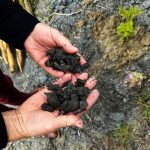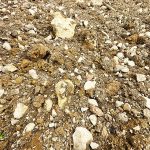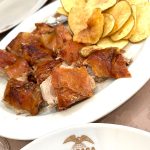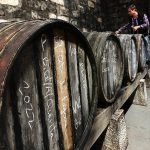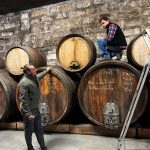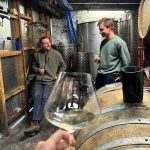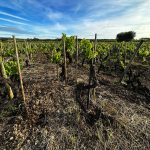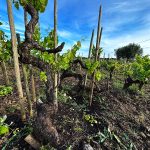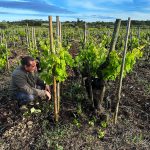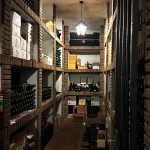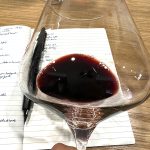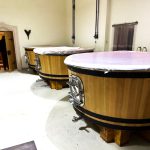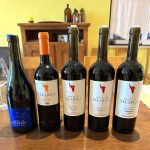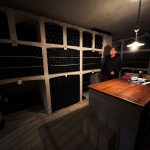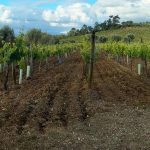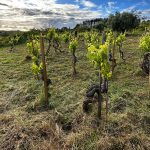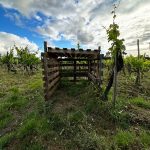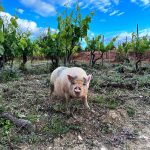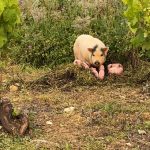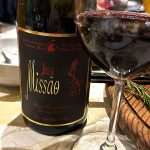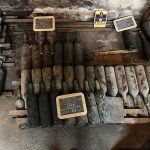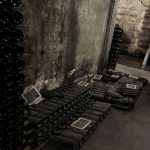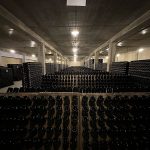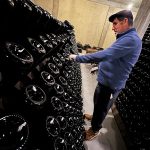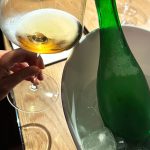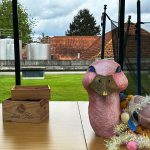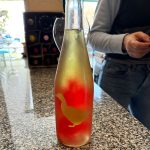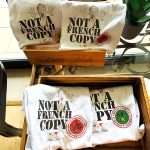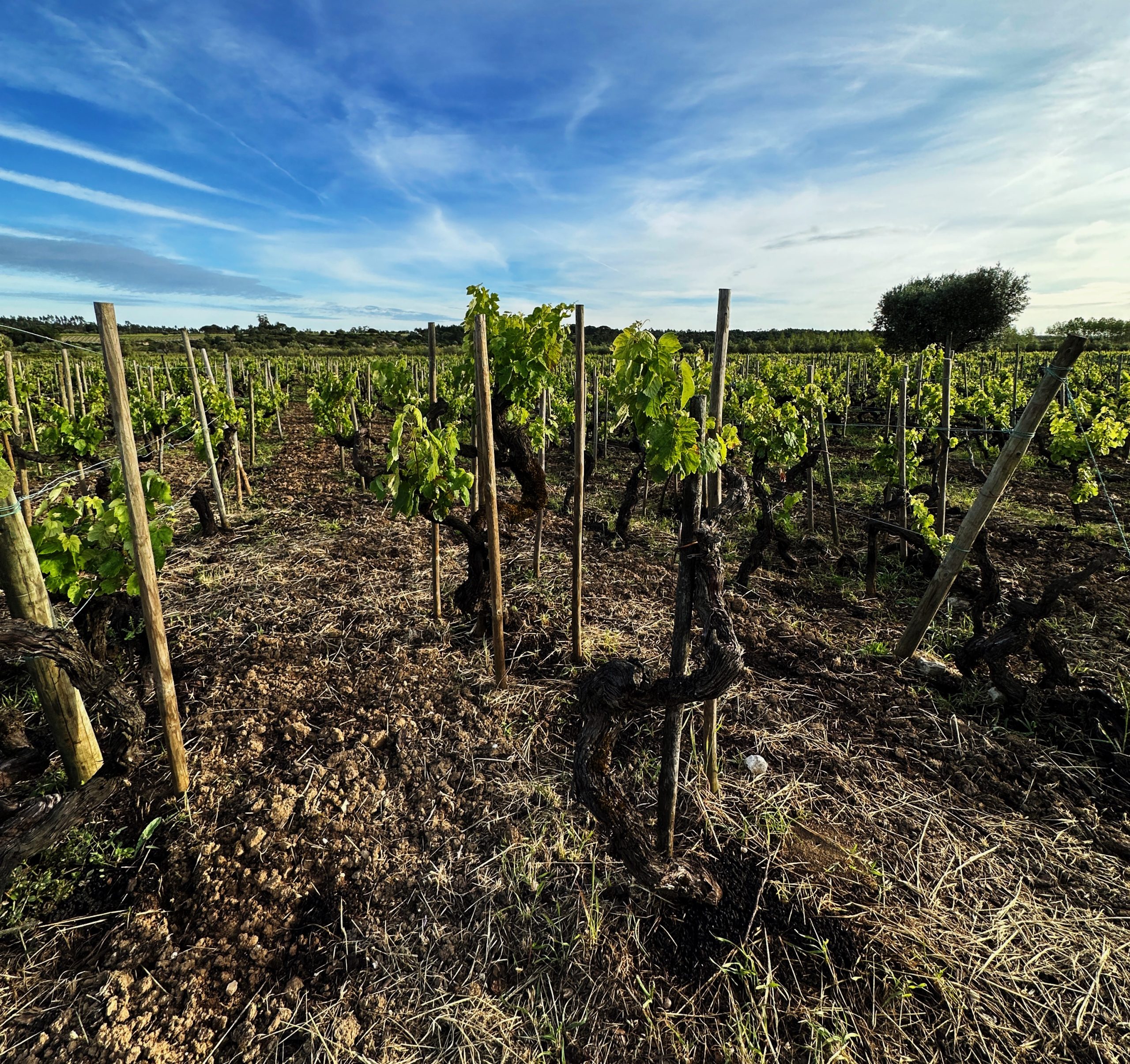
If you enjoy Barolo or Burgundy, I would recommend trying Bairrada, the Portuguese region most known for the red grape, Baga. These are lofty comparators, but justified: Baga retains high acidity when ripe, and has thin skins that yield plenty of tannins, both of which contribute to great longevity. The vine is vigorous and productive, requiring strenuous taming in the vineyard to produce a quality crop, yet it is translative of the terroir, yielding grapes with great quality potential. Baga is uniquely versatile, capable of producing sparkling wines of minerality and texture, flavourful rosés, light-bodied, elegant reds, and traditional “garrafeira” reds with heavy extraction, designed to be enjoyed after decades of cellaring.
The first Saturday of May is Baga Day, a one-day festival in its 10th year, showcasing the wines of 7 quality-focused producers in the region, collectively the Baga Friends. Each producer opens its tasting rooms, wineries, cellars, and even museums, to wine enthusiasts from Portugal and beyond. Each visitor is armed with a glass, and invited to visit as many producers as he desires. I was an eager participant this year arriving early in order to visit all 7 producers and immerse myself in the region.
A little background on Bairrada and Baga
Bairrada is a wine region around 20km inland from the west coast of Portugal, and therefore significantly influenced by the Atlantic Ocean. The mountain ranges that demarcate Bairrada to the east form a barrier, such that Dão, on the other side, is markedly hotter, drier, and more suited to Touriga Nacional.
Going to Bairrada this May, the weather was not dissimilar to cool, sporadically raining England, and I did not need to make any wardrobe adjustments. This maritime influence means mild, rainy winters and summers cooled by humid ocean breezes. The cooling influences enable a long ripening season for the development of complex flavours in the grapes. Indeed the temperatures at harvest range from 30+°C, enabling the grapes to ripen by day, to below 16°C at night, helping grapes retain freshness and acidity.
The humidity, however, exerts a certain disease pressure: Baga is resistant to mildews, which (in addition to its productivity) is a historic reason it has been planted here, but unfortunately its thin skins make it susceptible to Botrytis bunch rot, which strikes later in the season. This, coupled with its late ripening, mean that rain around harvest can be devastating. Producers anxiously weigh up waiting a few extra nail-biting days for perfect ripeness against the risk of rain and rot. Those with a lower appetite for risk harvest early to make Espumante. As a result, Bairrada produces two thirds of Portugal’s sparkling wine, the preferred wine pairing for the famous regional dish, Leitōes (suckling pig).
Like Nebbiolo and Pinot Noir, Baga is hard to grow. A vigorous vine, Baga will grow excessive foliage, which needs to be manually thinned to maintain airflow in the canopy, and allow sunlight to penetrate. It will naturally produce high yields, so cluster thinning or cordon training are adopted to reduce yields and achieve concentration.
The charismatic Luis Pato, Bairrada’s patriarch, the original champion of Baga and region’s best-known producer, set in motion Baga’s renaissance when he took over his parent’s winery in the 1980s. A chemical engineer by training and an entrepreneur in spirit, he implemented a dual-harvest approach from 2001, picking bunches in late July for sparkling, then 4 weeks later at full phenological ripeness for still red. The earlier harvest reduces the fruit load of the vine, so the 3 bunches per vine that were left ripened perfectly, and earlier than before, avoiding the September rains. Clever.
In terms of soils, Bairrada is a tapestry. The best soils for Baga are limestone with clay, and the sites considered Grand Cru are all rooted in this. The clay becomes blue-black as the level of organic matter increases, and the limestone, which rises to the surface, is riddled with fossils. Limestone is so prized for its ability to absorb large volumes of water, but release this slowly to the vine. When clay is also present, as in Bairrada, the calcium from limestone interacts with it to weaken the bonding between soil particles, opening up the soil to warmth, aeration, drainage and biodiversity. There are also sandy sites, well-suited to the white grapes (Bical, Cercial, and Maria Gomez) of the region, as well as curious own-rooted experiments enabled by sand’s inhospitality to Phylloxera – another of Luis Pato’s experiments!
Like in so many wine regions, there has been a shift in priority from quantity (needed to satisfy the thirst of African colonies past) to quality in Bairrada, which was awarded its DOC status in 1979. Today, 2,500 growers farm 6,500 hectares of vineyards, and 900 of these sell their grapes to SoGrape for Mateus Rosé, so you’ve probably tried Baga without realising!
But a growing number of producers, many of whom have studied winemaking and trained in multiple wine regions abroad, are tapping into the quality potential of Baga. These pioneers are not afraid of working the vineyard, experimenting, and continually adjusting their winemaking to bring out the best in a grape they love.
Credit: The Wine House
Credit: Baga Friends
A diversity of styles
Encountering the range of styles of Baga on my visit brought to mind the Barolo Wars of the 1980s – but without the fighting. In previous decades, the red wines of Bairrada have not found favour with domestic markets. Fermented with stems with heavy extraction and long maceration, the wines were highly acidic, astringent, inconsistently ripe and austere, at least in youth, requiring decades of cellaring to become approachable.
Today vinification of Baga lies on a spectrum from the heavily-extracted, muscular traditional styles to delicate, perfumed modern expressions.
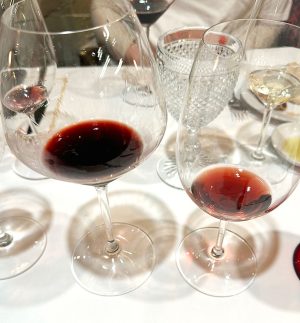
At the delicate, elegant end of this spectrum are the wines of Quinta de Baixo, purchased in 2012 by the prolific Dirk Niepoort. Dirk spotted the potential of Bairrada early on, describing it as the best terroir in Portugal. Today, talented young winemaker Miguel Silva is in charge, along with Dirk’s son, Daniel Niepoort. Miguel was born to make wine. As I tasted barrel samples with them both, from Zalto Universal glasses, Miguel climbed from cask to cask with the grace of a gymnast, suggesting an in-tune-ness and familiarity with their contents. The cellar at Quinta de Baixo is a carefully curated playground. As well as large casks, there are ancient-looking grey Fuders Daniel has brought over from Mosel, Germany, where he had lived prior to moving back to Portugal. The whites, from Maria Gomez and Bical are subtle, smokey, mineral, with high acidity, texture and lots of body. The same wine, aged in Mosel barrels was noticeably different – more fresh and vibrant. The Fuders are full of lees, including from previous years, Miguel told me, indicating the impressive level the lees reach in the cask – almost a fifth of the way up. Stacked above more traditional oak casks were smaller barriques – all used, and from these I tasted salty samples of white wines where flor had spontaneously appeared.
Miguel describes his approach in the winery as “simple: don’t manipulate it”. For Baga, he typically uses 30% whole bunches and ferments at low temperature for a long, slow maceration. Slow gentle punch-downs under a protective blanket of nitrogen are used once a day for the softest, gentlest extraction. The wines that result are fresh and bright, perfumed, with lifted red fruit, with a touch of spice and smoke on the nose. The palate shows acidity, precision, and fine tannins. Later, Daniel showed me the vineyard that yielded the one of the most impressive of these, Lote D, a 1.8 Ha block of individually staked centenarian vines, each uniquely contorted in a static dance.
In contrast, at Sidónio de Sousa, Paulo Sousa continues to vinify Baga the traditional way, making deeply coloured, concentrated, tannic wines for future drinking. Paulo introduced tonneaux made from exotic woods such as mahogany, from 2000 (before, only concrete had been used), softening the tannins and micro-oxygenating the wine without introducing overt oak character. “Garrafeira” is a term with a flexible definition depending on which producer you talk to, either to indicate a wine designed for long bottle ageing, a reserve wine, or in the case of Sidónio de Sousa, an exceptional vintage only declared in truly worthy years. As such, 1997, 2000, 2001 and 2005 were declared Garrafeiras, each stacked in a separate cubicle in a special cellar room. The height of the stacks bottles diminished with the age of the vintage. “1997 was a great year”, recounts Paulo’s son, Afonso, “the year my father got married, so he was very happy and inspired”. Portuguese wine writer, Luís Lopes, described the winery as intensely perfumed during the vinification of this wine, and told us that the wine had completed malolactic conversion in bottle, so when you drink it you need to swirl the decanter to aerate it and disperse the spritz. What results is a truly memorable wine: deep mahogany in the glass, viscous, and intensely tertiary in profile. I perceived charred steak, Worcester sauce, dark roast coffee beans and a braised beef cheek reduction. On the palate, this wine was savoury, with a large volume of clayey tannins. Wow.
It was perhaps a wine like this that so enchanted French winemaker François Chasans in 1998 that he uprooted his life as a caviste in Paris, purchasing Quinta da Vacariça within weeks, and moving to Bairrada within months, to explore the potential of Baga, making his first vintage in 2008. François is a purist – both in his viticultural approach and in his lack of interest in selling his wines. Indeed, you’re only invited to taste his wines if you are deemed worthy, and only sent a price list if you’ve tasted the wines and liked them!
On the Friday morning before Baga Day, I arrived at François’ house, where he lives with his Portuguese wife, Céu. His reception room opens out, Narnia-like, into his winery, containing several open-top wooden fermenters, concrete eggs, and amphorae. François believes that Baga needs at least 10 years of ageing, 15 years if it is a more serious wine. Over time, François has evolved his winemaking to use slightly less extraction, but says he is always true to Baga. He believes the wine is made in the vineyard and that work in the winery and cellar serve to magnify the vintage.
We tasted the 2008, which was made very traditionally with 100% whole bunches, not destemmed, and fermented by indigenous yeasts in open-top wooden lagares with 8 manual punch-downs per day. It has a deeply spicy nose full of cloves and Sarawak pepper. Its tannins are plentiful, big and grippy. By contrast, the 2016 was far more perfumed and fresh, with balsamic notes, resulting from only gentle pumpovers, and no punch downs. Its distinctive blue starry label is symbolic of François’ continued oenological exploration, that even after 8 vintages he is finding his style. François wines are like his children, not to be released into the world until they are sufficiently mature, and each beloved for different reasons.
Biodynamics, not homeopathy
The grapes for Quinta da Vacariça come from 2Ha of centenarian vines on a North-East facing slope in Tamengos, uncompromisingly farmed with biodynamic methods, and yielding a mere 15 hL/Ha (to put this into context, the DOC permits yields of up to 50 hL/Ha). François has even curated a small museum of biodynamics next door to his home-winery-cellar, showing photos of root development in biodynamic vineyards and samples of treatments he uses in his vineyard. This farming philosophy makes the vines more resilient, François explained. In the disastrously wet 2014 vintage, when botrytis decimated Baga grapes in the region, he actually had a harvest – albeit a tiny 8 hL/Ha – which he attributes to biodynamic treatments.
The biodynamic approach is a theme among the 7 producers that comprise Baga Friends. The vineyards owned by Vacariça, Niepoort (Quinta do Baixo), and Filipa Pato are farmed entirely biodynamically. Biodynamic principles are used by Luís Patrão at Vadio. Prior to this trip, I had viewed biodynamics with some suspicion, an attitude that is widespread in the UK wine trade. I have often heard biodynamics compared to homoeopathy, which is inaccurate, since active compounds are not diluted to the point of probabilistic uncertainty, but obviously concentrated, as I observed in the infusions being prepared. Many of the substances used for vines are also used for humans, such as aloe vera for sun protection, and valerian root as an anti-stress treatment.
The difference between conventional vineyards treated with herbicides, and organically and biodynamically farmed vineyards was most starkly apparently when I drove through tiny plots of ancient vines owned by Filipa Pato (Luis Pato’s daughter) that were green and teeming with life juxtaposed with rows of vines in bare brown soil owned by her neighbours. Filipa bent down to pick some wild oregano that the chef was going to use to cook the suckling pigs for Baga Day. She pointed out the fronds of fennel tops that edged another of her plots. “We have fava beans, wild asparagus, fennel, fig trees, olive trees, willows and wild flowers… we have this incredible biodiversity.” she says. You could happily forage for the ingredients for your supper in a single vineyard. The other plants have presented unexpected benefits, Filipa explained. The fig trees, for example, ripen simultaneously with Baga each year, and provide the local birds with a delicious meal that they prefer to consuming the grapes.
Award winning solera sparkling
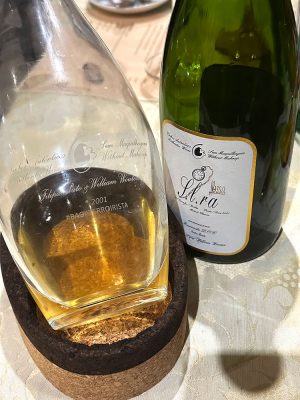
For Filipa, biodynamics extends beyond a methodology: it is a problem-solving mindset. When a colony of rabbits overran her vineyards and started eating the grapes in 2020, she avoided bunnicide by working out that they were simply thirsty. The grapes were saved by putting out water in the vineyard. Three years ago, Filipa introduced her greatest and most adorable innovation: the pigs. After evicting sheep, who started munching buds in March, Filipa was inspired by the region’s local delicacy, the suckling pig, to trial pigs. Happily, they turned out to be the perfect vineyard workers, digging around the vines just the right amount in search of food. Limestone-rich soils can become excessively compacted. The pigs till the soil around the untrellised, sometimes sprawling old vines, a strenuous job which had to be done entirely by hand previously. Filipa rotates the pigs around her plots to achieve an optimal balance for pig and vine. The day I visited, a sow had just birthed a litter of 5 tiny pink piglets, and I suffered cuteness overload, something FIlipa’s team shares. “They are always asking to spend time in the vineyards.” she says.
Importantly, the biodiversity and energy in the vineyards translates to delicious wines, which I tasted with Filipa and her delightful chef-sommelier husband, William Wouters. They really are a wine power couple. The ‘Nossa Calcario’ (Our Limestone) Bical 2022, from the first vineyard Filipa converted to organic, is textured and mineral, with intriguing hints of celery, anise, fennel, smoke, and umami. Their S.l.ra (Solera) sparkling, a blend of Baga and Bical, based on the first harvest in 2001 and blended with a selection of the most expressive harvests since, is rich and golden with age. It won “Wine of the Year” at national wine magazine, Revista de Vinhos, the first sparkling wine to have won this award.
Old vintages
One of Bairrada’s most valuable assets is its store of old vintages, stacked in endless tunnels underground. Perhaps the most extensive privately-owned cellar is found at Quinta das Bágeiras. As we walked around, I spotted diminishing stacks of unlabelled bottles from the 90s, enticingly thick with Zasmidium cellare. “I avoid putting labels on,” joked 3rd generation winemaker Mário Sérgio, “because whenever I label a wine, my wife sells it.” I am grateful that one bottle of 1989 Espumante, his first vintage, had not been labelled, as tasting this was one of the rich, toasty, and savoury highlights of the trip.
It is worth mentioning that retailing and serving the excellent older vintages of the large cooperative, Caves Sao Joao, the only reasonably priced and reliably available older wines I could buy in the UK, are how I got interested in the region originally. Their 1996, 1987, and 1975 red blends from Bairrada are currently imported by Marta Vine.
Scenes from Quinta das Bágeiras
Commercial considerations
It is clearly both challenging and rewarding being a modern winemaker in Bairrada. Most winemakers can’t afford to be purists like François Chasans, whose Parisian wine shop funds his winemaking in Bairrada. Luís Patrão, owner of Vadio who previously worked at Esporão, makes clean, fresh, elegant wines, including a delicious solera sparkling called Perpetuum containing 10 vintages. He farms 10Ha of vines divided into 27 individual plots. Like Niepoort and FIlipa Pato, Luís uses gentle extraction, a proportion of whole bunches, and restrained oak to produce a range of wines that have wide commercial appeal. He holds back 10% of Vadio Tinto each year enabling a new library release every year 10 years older than the current vintage.
Luís does work organically and biodynamically, but not always, because the risks are too great. If he lost a single vintage of a single wine due to disease, many of his importers would simply stop working with him. It is not uncommon for artisanal producers in the region to buy in grapes, because they wouldn’t have enough to produce commercially viable quantities of wine otherwise, and it is a slow, arduous process buying abandoned vineyards owned by families who have lost interest in winemaking.
Sometimes a project is utterly uncommercial, but deeply appealing. In 2004, Luis Pato planted a tiny plot of 0.8Ha with ungrafted Baga vines, and not on Phylloxera-unfriendly sand, but on clay-limestone, to explore what Baga may have been like pre-phylloxera. I walked around this vineyard with Luis’ middle daughter, Maria João Pato to whom Luis Pato is handing over the reins. For Maria João, this is a special wine. “I’m really happy you came to visit, because it’s an excuse to open this wine, which is my favourite.” she says. Only 290 bottles are made in a single vintage, matured in a single 150L barrel, and the yield drops each year as the vines are weak. Maria João mused about giving up on this wine altogether, but I hope she doesn’t. Wine lovers don’t just drink hedonistically with our senses, but intellectually and emotionally. Meeting the winemaker, hearing about the struggles of a difficult vintage, understanding the rarity of tiny yields, and absorbing the story of special vines all enhance our enjoyment of a wine, and this wine tells a wonderful story.
Experiencing Bairrada and participating in Baga Day 2024 was absolutely brilliant. I loved meeting a group of skilled winemakers, showcasing the potential of their region by making great wine in such a diversity of styles. The festival is rapidly gaining momentum, attracting over 400 visitors this year. I admire the impact Baga Friends is achieving in showcasing this region to the rest of the world, and hope this article has inspired you to visit too.
Wines to try
It depends on your preferences and the occasion, of course. Baga really is so versatile:
If you love traditional method sparkling wine, but would like to try something different:
- Luis Pato, Vinha Pan Espumante 2018
- Vadio, Perpetuum NV
- Filipa Pato, 3B Rosé NV (£20.70 from Hedonism)
If you enjoy textured, mineral, gastronomic whites:
- Filipa Pato, Nossa Calcario Branco 2022 (£36.80 from Hedonism)
- Sidónio de Sousa, Reserva Branco 2021
To drink with friends on a picnic, or sunny afternoon:
- Duckman (by Maria-Joao Pato), Rosa Duck Pet Nat NV (£20.75 from Chester Beer & Wine)
- Quinta das Bágeiras, Super Reserva Bruto 2019 (£29.25 from Festa)
- Vadio, Tinto 2020 (£16 from The Wine Society)
To accompany meatier fish, such as a fatty seared tuna steak or mackerel, duck, slow-roasted pork belly, or lamb:
- Quinta de Bágeiras, Fausto 2021
- Niepoort Quinta De Baixo, Poeirinho 2017 (£47 from Drinksmonger)
With steak:
- Vadio, Library Release Tinto 2013 (superb value at £25 from The Wine Society)
- Filipa Pato, Post Quercus Baga 2022 (£30 from Hedonism)
With game, guts, and rich stews:
- Sidónio de Sousa, Garrafeira – any vintage you can find!
- Quinta da Vacariça, 2011
- Quinta de Bágeiras, Garrafeira 2015
With wine geek friends with whom to meditate over:
- Quinta de Bágeiras, Pai Abel Rosé 2022
- Quinta de Bágeiras, Cercial 2020
- Quinta de Bágeiras, Pai Abel Tinto 2016 (£105 from Hedonism)
- Quinta de Baixo Vinhas Velhas Branco Niepoort 2016 (£40 from Hedonism)
- Filipa Pato, Nossa Missao 2019 (£130 from Hedonism)
- Niepoort Quinta De Baixo, Poeirinho Garrafeira 2015 (£87 from Drinksmonger)
Useful information for wine lovers:
- Baga Friends, who organise Baga Day
- Where to go for suckling pig: Mugasa, and Rei Dos Leitoes
Information for the UK trade:
| Producer | Importer |
|---|---|
| Niepoort Quinta De Baixo | Halo Wines |
| Filipa Pato | Clark Foyster |
| Vadio | Justerini & Brooks |
| Luis Pato and Duckman | Raymond Reynolds |
| Quinta das Bágeiras | Festa |
| Caves São João | Marta Vine |
